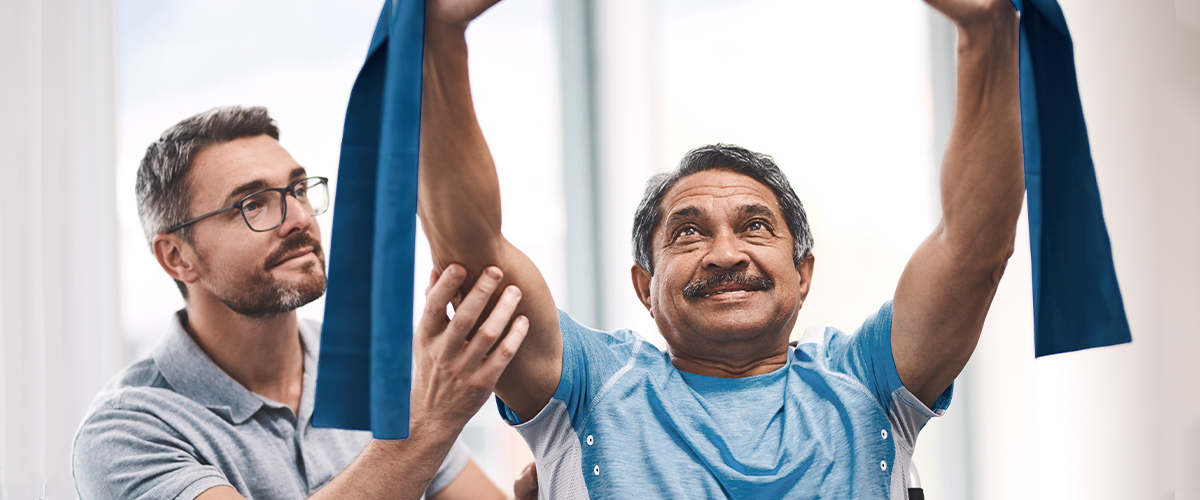What it is, when you may need it and how it can help
Have you suffered a musculoskeletal injury? Are you planning or have you had orthopedic surgery? Has your injury or operation resulted in pain and limited mobility? If you answered yes to any of these questions, you may benefit from orthopedic therapy.
What is orthopedic therapy?
Orthopedic therapy is a specialized type of physical therapy performed by an orthopedic certified specialist (OCS) that focuses on the treatment of musculoskeletal conditions that cause pain and limited physical mobility. The ultimate goal of orthopedic therapy is not only to treat the symptoms, but also to resolve the cause of those symptoms so that the patient can experience lasting comfort and restored range of motion, as well as regain the ability to perform key tasks and activities.
Orthopedic therapists use a variety of tools and exercises that work with the body’s natural movement to target healing and avoid further injury. They start by closely assessing the condition of the injury and then tailor activities to benefit the patient’s specific needs. Conditions that may benefit from orthopedic physical therapy include, but aren’t limited to:
- Fractures
- Muscle strains
- Tendonitis
- Arthritis
- Ligament sprains
- Post-operative conditions
- Bursitis
If not treated, these conditions can have lasting impacts on a person’s daily life and functioning, resulting in reduced independence and hindering the ability to perform basic tasks and activities. Over time, the condition may progress, symptoms may increase in severity, and the patient’s emotional well-being may be impacted by feelings of helplessness.
On the other hand, with proper treatment, orthopedic therapy can ensure that patients don’t have to suffer. With perseverance and focus, many patients are able to overcome their injuries, and maintain the ability to perform physical tasks that would have otherwise remained hindered.
How do I know if orthopedic therapy is right for me?
When you sustain an injury or have surgery involving your joints — such as a hip or knee replacement — your mobility will significantly decrease due to swelling, stiffness, and pain or discomfort.
After surgery, your doctor will either put you on a strict activity schedule or refer you to an OCS. The guidance of an OCS is important because, while staying active is a crucial part of healing, the wrong type or amount of activity can increase the risk of re-injury.
What happens when I’m referred for orthopedic therapy?
Once referred to an OCS, you’ll receive a prescribed regimen of specific exercises and activities to be performed both in the therapy center and at home. Since remaining active is vital to the healing process, the exercises prescribed by orthopedic physical therapists are designed to help condition and strengthen the body while allowing it to heal itself.
Depending on your specific needs, an OCS may suggest the use of an assistive device such as a cane, walker or sling. They may also use a variety of tools in treating you, such as:
- Exercises with or without exercise equipment
- Therapeutic modalities such as electrical stimulation, ice, heat or dry needling
- Manual therapy
- Soft tissue massage
Each of these methods, when performed by an OCS, will help improve your mobility, alleviate pain and assist your body in healing itself.
Will I need to exercise at home?
You can expect that, in addition to the exercises and procedures used in the orthopedic physical therapy office, you’ll be assigned some exercises to be performed on a schedule at home. These are often low-impact, low-intensity exercises and activities designed to gauge your physical limitations, so that your OCS can gradually guide you to health. Exercises and activities may include:
- Balance exercises
- Strengthening exercises
- Endurance exercises
- Stretching and flexibility exercises
- Polymetric (jumping-type) exercises
- Exercises to gradually increase range of motion
- Functional mobility exercises
You’ll receive coaching in the therapist’s office so that you’ll be able to consistently and properly perform each exercise — factors that are key to avoiding re-injury or placing strain on the healing injury.
Short-term rehabilitation at Galleria Woods
At Galleria Woods, we offer short-term rehabilitative services in a warm and comfortable residential setting to help you recover from illness, injury, or surgery such as a joint replacement. Our skilled team of therapists will develop a plan of care based on your individual needs to help ensure successful healing and get you back to living the life you enjoy as quickly as possible. We accept new patients on a direct admission basis as space permits.To learn more about short-term rehabilitation at Galleria Woods, simply call us at 205-390-6600.





